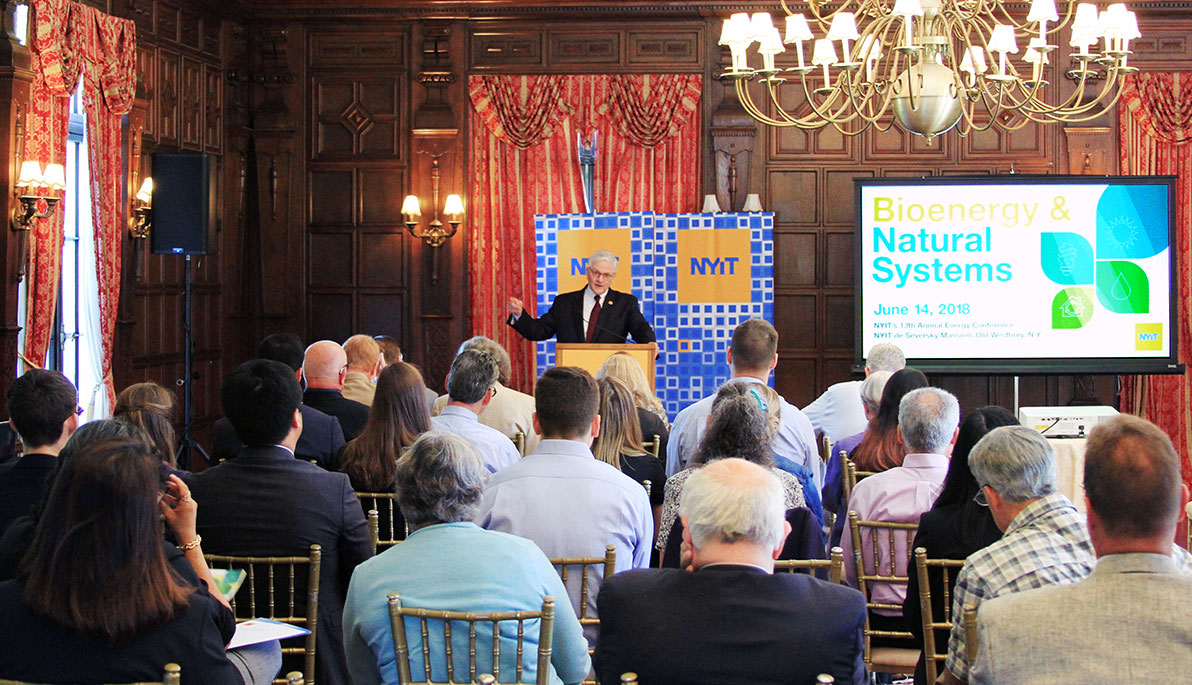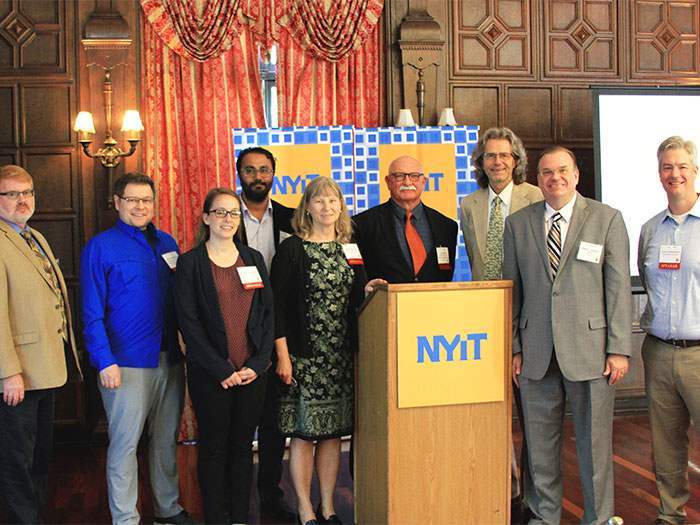
How Bioenergy Affects Natural Systems: 13th Annual Energy Conference
June 21, 2018
Just days after world leaders at the G7 forum in Charlevoix, Canada, named clean energy technology one of their five priorities, experts convened at NYIT’s 13th Annual Energy Conference, “Bioenergy and Natural Systems,” on June 14 at NYIT de Seversky Mansion in Old Westbury, N.Y. “Energy to power a world that craves more technology and higher standards of living with a population of more than 7 billion human beings is, to say the least, daunting … but what better place to do this than NYIT?” said NYIT President Hank Foley, Ph.D., in his remarks.
The conference, which was sponsored by the Long Island chapter of the U.S. Green Building Council and the Association of Energy Engineers, touched on important issues in the industry, including wind power. The day after the conference, the U.S. Department of Energy (DOE) announced that the New York State Energy Research and Development Authority (NYSERDA) received an $18.5 million grant to develop “a national research and development consortium for the offshore wind industry,” designed to “drive innovation through [R&D] that will cut down the costs of offshore wind technologies…and explore advanced technological solutions.”
“Governor Cuomo wants to make New York State number one in the nation in offshore wind energy and a national model leading climate change and extreme weather mitigation,” said Nada M. Anid, Ph.D., vice president of Strategic Communications and External Affairs. “The state employs 145,000 employees in the energy sector, 110,000 of whom work in renewables. Offshore wind alone will bring a boost to the Long Island economy and NYIT, through its longstanding, flexible master’s degree program and advanced certificates is well positioned to contribute to that growth.” NYIT offers programs in Energy Management, M.S.; Energy Technology; Facilities Management; Infrastructure Security Management; and Environmental Management both online and in person.

Speakers at the 13th Annual Energy Conference pose with Robert Amundsen (second from right), chair of the event. From left: Timothy Volk, Irakli Loladze, Rebecca Trojanowski of Brookhaven National Laboratory, Shishir Chundawat of Rutgers University, Virginia H. Dale, David Beutel, Keith L. Kline, and Scott A. Banta.
Robert N. Amundsen, Ph.D., associate professor, director of the energy management program, and chair of the conference committee gave the opening remarks and reminded the attendees that “Bioenergy has the potential to move our economy away from fossil fuels, and build a new foundation based on cleaner, greener sources of energy.”
Attendees and presenters (including from University of Tennessee, Oak Ridge National Laboratory, Columbia University, SUNY College of Environmental Science and Forestry, Bryan Medical Center, Rhode Island Coastal Resources Management Council, Rutgers University, Stony Brook University, and Brookhaven National Laboratory) discussed unexpected discoveries and unintended consequences affiliated with bioenergy production.
Keynote speaker Virginia H. Dale, Ph.D., adjunct professor at the University of Tennessee, Knoxville, presented a comprehensive, optimizable approach to assess progress toward sustainability goals. She stressed the importance of identifying and contextualizing sustainability indicators including socioeconomic factors such as social well-being, energy security, external trade, and profitability. Dale, who contributed to the Climate Change Panel that led to former Vice President Al Gore receiving the Nobel Prize, also emphasized the need to engage stakeholders to gain acceptability.
Keith L. Kline, Ph.D., of Oakridge National Laboratory, stressed the DOE’s commitment to sustainability and innovative renewable energy technologies.
Timothy Volk, Ph.D., senior research associate at SUNY College of Environmental Science and Forestry noted that “a field contaminated by salt mining waste had no plant life 20 years later, except for willow shrubs. But these fast-growing plants can transform unproductive land into valuable farms for growing willow as a fuel.”
And it’s not just land that can be impacted. Even wind energy can have unintended consequences. For example, offshore wind farms can also have a negative impact on marine life, although there are ways to protect them. “We learned about the impacts on fisheries due to offshore wind farms near Rhode Island, which provided valuable insights about how to protect marine life,” said conference speaker David Beutel, aquaculture coordinator at Rhode Island Coastal Resources Management Council, who also reminded attendees that wind turbines will soon be installed south and east of Long Island.
“Science is full of surprises,” said Irakli Loladze, Ph.D., associate professor at Bryan Medical Center. “Since carbon dioxide helps plants grow faster, everyone expected they would have more nutrition.” But his research shows the opposite. “World population is increasing and atmospheric carbon dioxide levels are rising. This has profound implications,” he said.
More Features

An Alumnus’ Commitment to the Environment
As an energy management graduate from New York Tech’s Vancouver campus, Jasdeep Gulati (M.S. ’22) is highly invested in educating people about environmental and climate sustainability.

Vancouver Faculty Win University-Sponsored Research Awards in New Program
The new Global Impact Research Grant (GIRG) program has been developed to keep Vancouver-based faculty connected to faculty and research projects being conducted on the university’s New York campuses.

Studying Climate Change One Degree at a Time
Junhua Qu (M.S. ’24) began her collegiate journey in Beijing. But, her interest in climate change took her to New York Tech’s Vancouver campus to study energy management.
